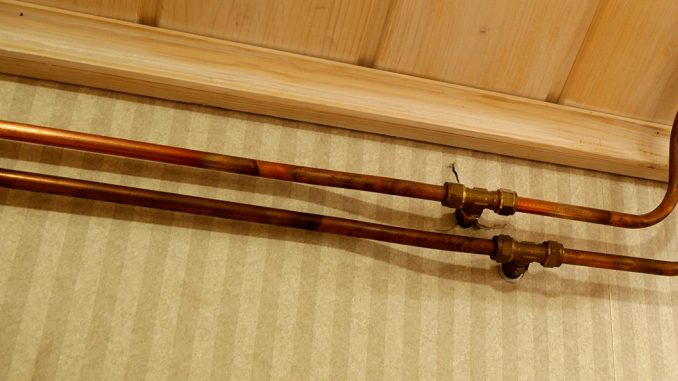
A pinhole leak is one of the most common types of pipe repair that we get asked about – and knowing how easy it can be to fix one can often save you a small fortune in avoidable plumber’s fees.
Most pinhole leaks in domestic copper pipes are a result of pitted corrosion on the inside of the pipe breaking through to the outside, causing the tiniest of cracks to appear. When this happens, water in the pipe begins to leak out of the damaged section.
Because it is impossible to protect the inside of pipework and control what is going on within systems, preventing pitted corrosion is extremely difficult.
Nobody is able to conclusively say what causes pitted corrosion, either. It could be happening for a whole host of reasons; high levels of chlorine in your water supply; a problem with the water pressure; or corrosion particles escaping another rusted component, such as a boiler, and building up on the inside of the pipe.
Pinhole leaks are not just restricted to copper pipes corroding away. Accidentally drilling into a pipe can cause a pinhole in materials including steel and cast iron. Being able to fix a pinhole leak is a skill that can serve you well in any number of applications.
So, how exactly do you fix a leaking pipe with a pinhole? Here are four easy methods.
Fix a pinhole leak using epoxy putty
Because pinhole leaks are small, the easiest repair method is to fill them with epoxy putty. The best tool for the job is an epoxy putty stick, which combines the resin and the hardener in a pre-measured format.
To use an epoxy putty stick, you tear off the amount of putty required and knead it by hand. The putty will quickly turn to a uniform colour, at which point you push it into the pinhole. It will then cure and harden, filling and sealing the pinhole.
Repairs made with epoxy putty are long lasting but not permanent. To reinforce the pinhole pipe repair and turn it into a permanent solution, you can overwrap the putty with a pipe repair bandage. When the resin infused in the bandage is activated, it will cure to provide a rock hard, impact resistant layer over the initial repair.
Repair a pinhole leak using pipe repair tape
One downside of epoxy putty is that it will struggle to bond with pipes when water pressure cannot be turned off – the higher the water pressure, the less chance of a successful repair.
In these instances, a good alternative is a waterproof pipe repair tape. Such tapes are made from self-fusing silicone and when stretched and wrapped around a pinhole, will form a solid rubber band over the leak area for a pressure resistant repair.
Just like with epoxy putty, a pinhole leak repair made with waterproof repair tape can be reinforced with a pipe repair bandage for an added layer of protection.
Fixing a pinhole leak with a pipe repair clamp
Pipe repair clamps provide another straightforward method of repair for a pinhole leak. They consist of a metal sleeve with a flexible pad of rubber inside.
The clamp is placed over the area of pipe requiring repair. When the screws on the clamp are tightened, it will bolt down and encompass the pipe, sealing the pinhole leak.
There are limitations to pipe repair clamps. Because they must encompass the pipe, they can only be applied to straight sections.
If the pinhole leak is on a tee or an elbow – as is often the case when pitted corrosion is the culprit – then a clamp will not provide an effective repair.
Replacing pitted pipes
If you are unfortunate enough to suffer from pinhole leaks on a frequent basis, then this is often a sign of extensive pitted corrosion throughout your pipework system.
In this instance, you may be better off replacing the damaged sections of pipe as high levels of pitted corrosion can lead to much more serious issues than pinholes.
The older your pipes, the more likely they are to need replacing. The lifespan of copper pipe can be anywhere between 20 and 50 years depending on the workload placed upon the system.
If your property is served by copper pipes over 20 years old and pinhole leaks are becoming a recurring issue, then it might be time to consider pipe replacement rather than repair.

Leave a Reply